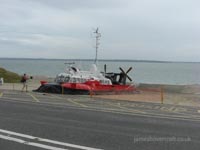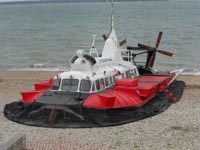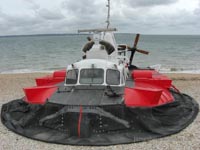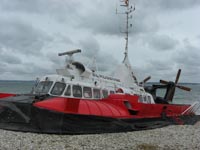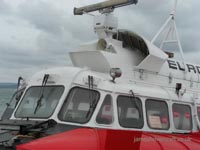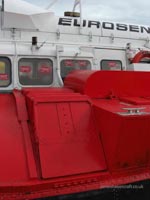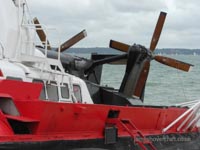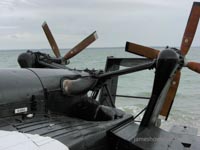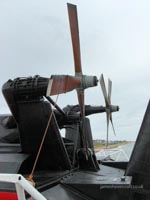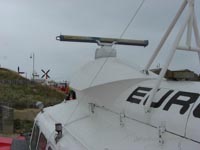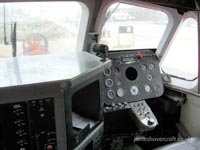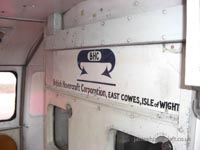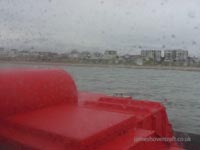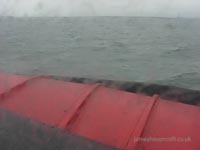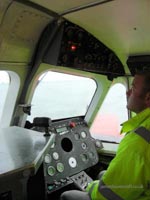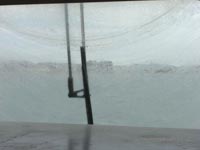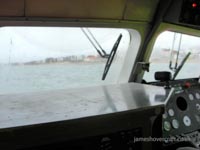At Hovershow 2009 I was extremely lucky (and thus remain forever grateful to the Hovercraft Museum team and the SRN6 crew that day, ex-Canadian Coastguard engineer Paul Augusta and pilot Colin Shew, and Hovertravel pilot Robert Trussler) to have both seen, climbed aboard, and had a flight in an SRN6 hovercraft.
Parts of this particular craft once boasted the name "Sure", of the two Hoverlloyd twin craft to operate between Pegwell Bay and France back in the 1960s during Hoverlloyd's first years of service. An amalgamation of two craft, other components were from SRN6 "Freedom" (Mark, 2009). She then went on to a life outside of the passenger field, touring the world. This craft was then stretched, and converted to a twin-propeller configuration to reduce operating noise. Most recently, before purchase by the Hovercraft Museum, SRN6 017 acted as a marine research vessel, bearing the onboard equipment and electronics to match such a role.
The SRN6 Twin-Prop design was created to, among other things reduce operating noise from the craft's "angry wasp"-sounding propeller, the original tips of which were so fast that they broke the sound barrier due to the propeller's size and high speed. Twin Props reduced each blade's diameter and thus tip speed, subsequently negating the requirement to go supersonic to provide the necessary thrust to drive the craft forward.
This page contains photos from around the Museum's SRN6, and a link to a video(s) page of the short trip around the Solent infront of HMS Daedalus. Click for more information about the SRN6.
Canadian Coastguard
Paul worked with the Canadian Coastguard since 1968 initially as a rep for Westland Aerospace in the UK, initially having started out as an apprentice for Saunders & Roe hovercraft. He was chief engineer with Hovertravel, involved with hovercraft activities in the Middle East and the Arctic to do with oil exploration back in the '60s. Canadian Coastguard operated 5 SRN6s in total, 2 from Vancouver and 3 from Yellowknife (??). They now operate 4 AP1-88 craft for Search and Rescue and Ice Breaking roles.
SRN6 Twin-Prop Walkaround and Flight at Hovershow 2009
About a 10-minute short hover-around was afforded to a very lucky few at Hovershow 2009 on the Museum's SRN6 Twin Prop. Piloted by Hovertravel's own (??), and crewed by many SRN6 veterans, this short hop took us about a mile East of the Daedalus slipway, keeping relatively close to shore, but proving that this, the oldest operational hovercraft in the world, is still made of strong stuff some 40+ years on. SRN6 017 (the original Sure, later stretched, and converted to twin-propeller and outfitted for research purposes). This craft carries remnants of old research kit control panels
by James Rowson.
-
SRN6 017 landed as viewed from the top of the Daedalus approach ramp
-
SRN6 017 landed on the beach at Lee
-
As viewed from her bows, landed on the beach at Lee
-
Landed as viewed from the port bow
-
Closeup of the bow of the craft showing the RADAR antennae, air scoop, and original front-loading access bow ramp
-
The lateral "puff port" on the side of the craft, opened on demand by the pilot, supplied by lift air from the plenum chamber
-
Looking aft toward the two main rear propellers
-
The engine assembly and two main propellers, along with the rudder and elevator tailfin of the SRN6
-
Side-on view of the two main propellers and their mountings
-
Looking forward along the top of the craft, from the side access door
-
Control panel, lacking Direction Indicator but otherwise still there
-
The hollow-bottomed partitioned observation pool bulkhead, with BHC logo (presumably post-Hovercraft Museum arrival) emblazoned upon it
-
Looking right toward Lee-On-Solent from the SRN6, in the foreground is one of the four "puff ports", and the skirt
-
Shot showing outside of plenum chamber and the skirt showing
-
A Hovertravel pilot took the role of flying the N6 for this trip, a new experience with jet turbine hovercraft!
-
View from the (rather salt-spray stained) front window during Solent trip
-
Looking forward during Solent trip
Click here for video of this trip.

